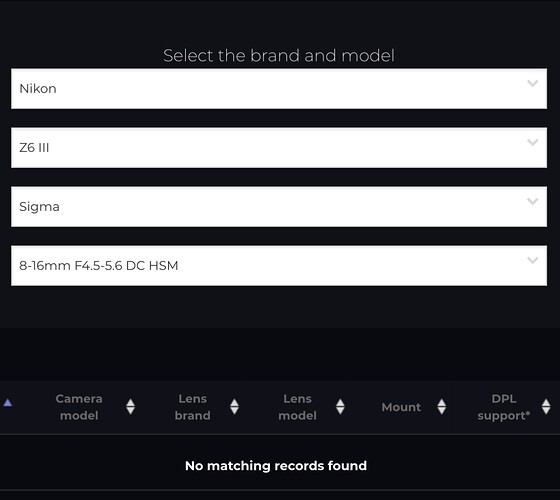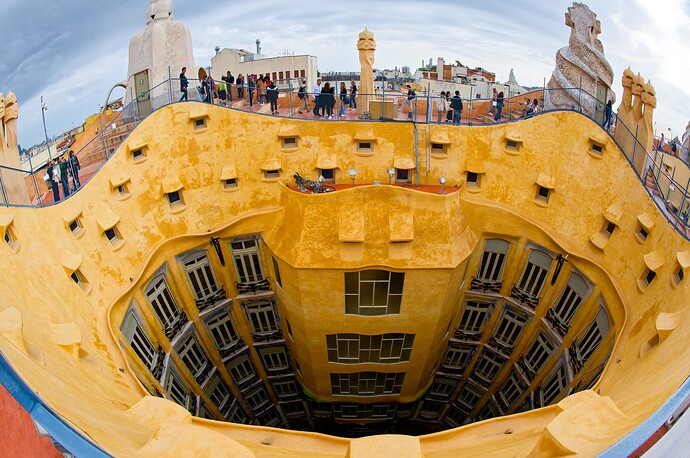I have observed that optics modules are very specific: body plus lens plus optional teleconverter must all be supported if certain PL Elite features are to be available. For those who are regularly using Nikon Z bodies plus FTZ plus F mount lenses (Nikon or non-Nikon), does the FTZ (and presumably the FTZII) also appear in the list – that is, a Z plus FTZ plus F mount lens have the FTZ appear or not? In my limited testing of a Z7 with a FTZ plus one of my existing F mount lenses, the FTZ did not appear in the optics module description (eg., Nikon Z7 + Sigma 150-600 … DG … S – no mention of the mandatory FTZ required to mount that F mount lens on a Z mount body). For those on this list who routinely are using Z mount plus F mount lenses plus PL Elite, does the FTZ ever appear in the relevant optics module?
FTZ: No optics in the device (it’s basically a spacer to get the same lens distance from the sensor as for a DSLR, plus electronic connections to the lens, etc.). Therefore no need for a different module. F mount lenses work great.
I fully agree – and hopefully so will DxO implementation persons. The reason I was asking is that the application clearly could detect than a F mount lens is on a Z mount body.
To clarify: PL optics modules show F lenses that work with Z cameras (i.e., camera body + lens module). It doesn’t mention that an FTZ is required to do this, presumably because Z owners know that the FTZ it the only way of mounting those lenses on a Z body. I don’t think third party adaptors (e.g., for Sony lenses) are supported at this point.
As I noted above, compatible F lenses work well with my Z6. I currently have an F AF-S Nikkor 85mm f/1.8 and an AF-S VR Zoom-Nikkor 70-300 f/4.5-5.6G IF-ED.
Define “great” ![]()
I found F-lenses to be a safe way too avoid the typical colour blobs in very contrasty front light situations. But admittedly, Z-lenses usually are sharper than their F-counterparts, as they are the newer design (like 14-24/2.8, the old flare collector). So, the newer ones are “greater” although some of them provoke said colour blobs due to poor rear element design: the sensor is reflecting light towards the rear element and some lenses give that light back.
I was surprised when I just checked the modules for Z bodies. I thought the Z 7II has a different sensor than the Z 7 but apparently for DxO that doesn’t matter that much. Or I was mistaken, because I simply don’t care anymore about Nikon Z. ![]()
Hello,
First the Nikon Z7 II has exactly the same image sensor as the original Nikon Z7.
Second, about FTZ, FTZ II or any other adaptor ring we don’t specify it in the name of modules because there is no glass inside so it doesn’t modify dostorsion, vignetting or lens sharpness measures. Of course when we do a new camera support we check that our correction are correct on lenses used with an adaptor ring.
Regards,
Marie
Thank you for clarifying. Later I remembered, Nikon was just doubling the amount of (slightly outdated) image processors and memory card slots, but the sensor remained the same. Except the usual marketing mambo jambo. Well, the colour blobs are not appearing as much on the Z 6 as they are on the Z 7 together with the then new 24-70/4, but if the appear, I can’t do much about it in post.
Hello. I come back with this old subject. I recently purchased a Nikon Z6III and I use it with the FTZ2 adaptor ring and Sigma 8-16 mm f/4,5-5,6 DC HSM lens. Both the camera and the lens are supported, but the combination is not recognized. How is this possible ? Regards.
Thanks a lot. Yes, this is what I saw. But I don’t understand why the combination is not supported as the camera is supported and the lens also. I used it previously with the D5300 and it worked perfectly. And as this (excellent) lens is old, I suppose that if the combination is not supported now, it will never be which is sad…
More importantly, it’s a DX (APS-C like) lens, which is supported on DX camera like D5300. But Z6III is full-frame…
Due to the different rendition of the sensors (microlenses on the light receiving diodes), a lens can perform VERY differently in terms of chromatic aberration, sharpness and even light falloff on two sensors of same size but of a different generation.
So, any lens correction needs to be customized for a specific camera: the only correction which would not need body-to-body customization is geometric distortion.
Same applies in my case to the Nikon AF 16/2.8D: it has a correction for my D700, but NOT (yet) for the Z6 when used with the FTZ.
That’s fish-eye, produced 1993-2020, afaik. Good to know, didn’t try it yet on Z8. I loved that lens for mountain hiking – it was so light ![]()
Strangely enough, AF DC-Nikkor 135mm f/2D is supported on Z8 (and Z6), although it’s also a very old lens (produced 1995-2020).
Yes, it’s exactly that fisheye! Even without specific lens profile, it can still give decent results with some unsharp mask.
And yes, I also have the 105/2 DC, and that one is supported with FTZ on the Z6 too like its brother 135.
That would mean there’re 2 tests made: one for the camera and one for the lens. And they’re combined afterwards.
But the Z6-III has been tested and the AF 16/2.8D has been tested. How can that lens behave different on another camera.
George
No, just one test: for that lens WITH that camera.
You cannot perform separate generic tests (camera without lens, and lens without camera) and combine them. The way the light rays coming out of a specific lens, interact in a unique way with the sensor of a specific camera.
And by “sensor” I also include the very specific filter in front of it: a Nikon D780 might have the same sensor of the Z6 from the electronic point of view, but the filter is slightly different, and might give a different result… so the combination has to be retested.
On the other hand, Z6 and Z6II have 100% the same sensor, so no need to retest the combination. Not so sure about the Z6III, which has a slightly different sensor.
From a practical point of view that seems nearly impossible to me. Every time a new camera comes they have to build a collection of lenses to test. And every time a new lens comes they have to build a collection of camera’s to do the testing. We’re talking about a lot of money and time and place and logic.
George
Absolutely so, and that’s why it takes months to include new correction modules.
It can be avoided only if a new camera uses exactly the same sensor and filter pack of a previous one.
And we are always told new tests are dependent on getting a lent copy. There is just one set of tests on cameras and lenses and existing modules are used when matched to new gear so why we endlessly have this issue of matching ourselves existing tested gear is to my mind a con as they clearly do not retest cameras and lenses together as new ones come out



